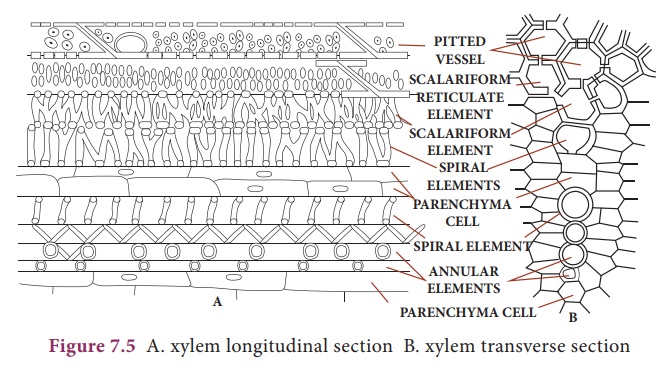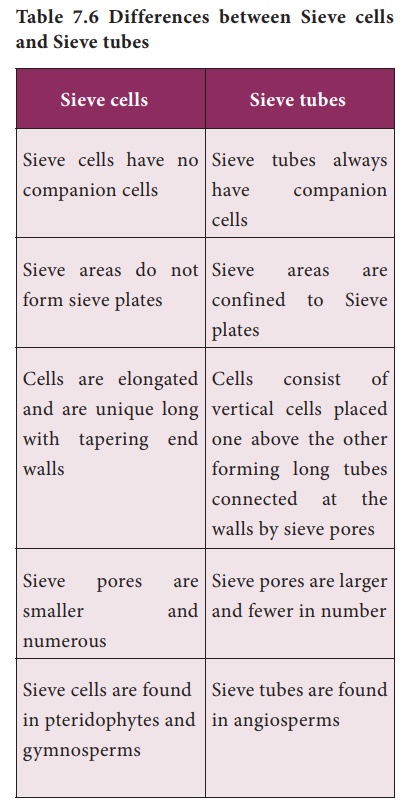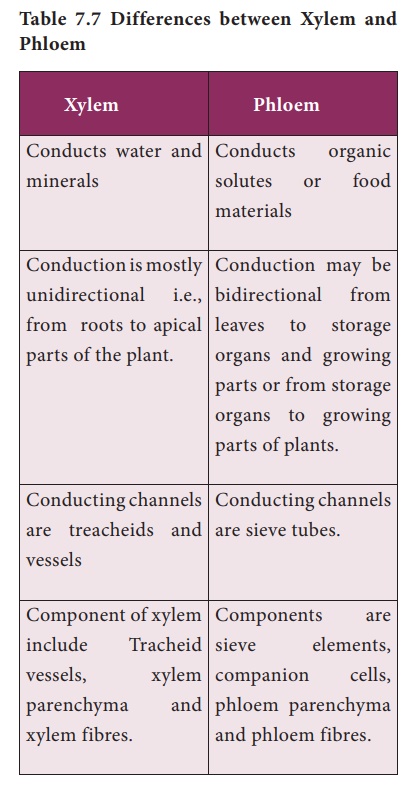Classification, elements | Plant Permanent Tissue - Complex tissues | 9th Science : Organization of Tissues
Chapter: 9th Science : Organization of Tissues
Complex tissues
Complex tissues
Complex tissues are made of more than one type of cells that work together as a unit. Complex tissues consist of parenchyma and sclerenchymacells. However,collenchymatous cells are not present in such tissues. Common examples are xylem and phloem.

Table 7.4 Differences between Meristematic tissue and Permanent tissue
Meristematic tissue
· Component cells are small, spherical or polygonal and undifferentiated
· Cytoplasm is dense, and vacuoles are nearly absent
· Intercellular spaces absent
· Cell wall thin and elastic
· Nucleus is large and prominent
· Cells grow and divide regularly
· Provides mechanical support and elasticity to the plant body
Permanent tissue
· Component cells are large, differentiated with different shapes
· Usaually large central vacuole present in living permanent cells
· Intercellular spaces present
· Cell wall thick
· Nucleus is less conspicuous
· Cells do not normally divide
· Provides only mechanical support
1. Xylem
Xylem is a conducting tissue which conducts water, mineral nutrients upward from root to leaves. Xylem is also meant for mechanical support to the plant body. Xylem is composed of different kinds of elements. They are (i) xylem tracheids (ii) xylem fibres (iii) xylem vessels and (iv) xylem parenchyma.
i. Xylem tracheids
They are elongated or tube-like dead cells with hard, thick and lignified walls. Their ends are tapering, blunt or chisel-like. These cells are devoid of protoplast. They have large lumen without any content. Their function is conduction of water and providing mechanical support to the plant.
ii. Xylem fibres
These cells are elongated, lignified and pointed at both the ends. Xylem fibres help in conduction of water and nutrients from root to the leaf and also provide mechanical support to the plant.
iii. Xylem vessels
They are long cylindrical, tube like structures with lignified walls and wide central lumen. These cells are dead as these do not have protoplast. They are arranged in longitudinal series in which the partitioned walls (transverse walls) are perforated, and so the entire structure looks-like a water pipe. Their main function is transport of water and minerals from root to leaf, and also to provide mechanical strength.
iv. Xylem parenchyma
Its cells are living and thin walled. The main function of xylem parenchyma is to store starch and fatty substances.

2. Phloem
Phloem like xylem is a complex tissue and consists of the following elements.
(i) Sieve elements
(ii) Companion cells.
(iii) Phloem fibres
(iv) Phloem parenchyma
i. Sieve elements
The conducting elements of phloem are collectively called as Sieve elements. They may be segregated into less specialised sieve cells and more specialised sieve tube elements.
Sieve tubes are elongated, tube-like slender cells placed end to end. The transverse walls at the ends are perforated and are known as sieve plates. The main function of sieve tubes is translocation of food, from leaves to the storage organs of the plants.
ii. Companion cells
These are elongated cells attached to the lateral wall of the sieve tubes. A companion cell may be equal in length to the accompanying sieve tube element or the mother cell may be divided transversely forming a series of companion cells
iii. Phloem parenchyma
The phloem parenchyma are living cells which have cytoplasm and nucleus. Their function is to store food materials.
iv. Phloem fibers
Sclerenchymatous cells associated with primary and secondary phloem are commonly called phloem fibers. These cells are elongated, lignified and provide mechanical strength to the plant body.

Table 7.5 Differences between Tracheids and Vessels
Tracheids
· Formed from single cells
· Ends are oblique and taper
· Fraction of a cm in length
· Walls are thick, lumen-narrow
Vessels
· Made up of number of cells.
· ends are round and transverse.
· Several cms in length
· Walls are less thick, lumen- wide.
Differences between Sieve cells and Sieve tubes

Sieve cells
· Sieve cells have no companion cells
· Sieve areas do not form sieve plates
· Cells are elongated and are unique long with tapering end walls
· Sieve pores are smaller and numerous
· Sieve cells are found in pteridophytes and gymnosperms
Sieve tubes
· Sieve tubes always have companion cells
· Sieve areas are confined to Sieve plates
· Cells consist of vertical cells placed one above the other forming long tubes connected at the walls by sieve pores
· Sieve pores are larger and fewer in number
· Sieve tubes are found in angiosperms
Differences between Xylem and Phloem

Xylem
· Conducts water and minerals
· Conduction is mostly unidirectional i.e., from roots to apical parts of the plant.
· Conducting channels are treacheids and vessels
· Component of xylem include Tracheid vessels, xylem parenchyma and xylem fibres.
Phloem
· Conducts organic solutes or food materials
· Conduction may be bidirectional from leaves to storage organs and growing parts or from storage organs to growing parts of plants.
· Conducting channels are sieve tubes.
· Components are sieve elements,
· companion cells, phloem parenchyma and phloem fibres.
Related Topics

